Farmers’ Indigenous Knowledge of Soil Management in an Altitudinal Gradient in Southern Ecuador
Abstract
1. Introduction
2. Materials and Methods
2.1. Study Area
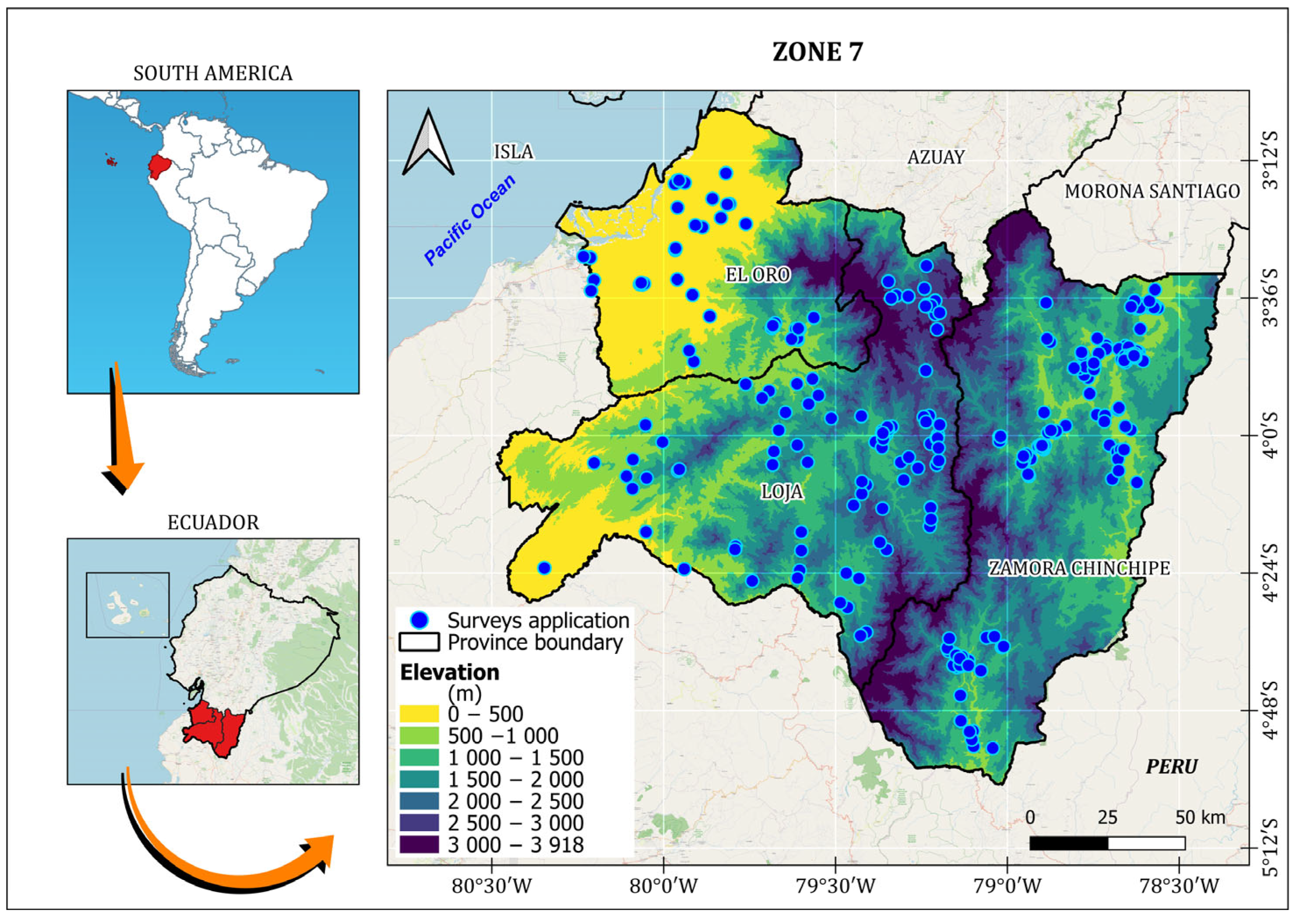
2.2. Data Collection
2.3. Statistical Analysis
3. Results
3.1. Traditional Knowledge in Soil Management
3.2. Visible Indicators of Soil Fertility
3.3. Soil Organic Carbon Stocks and Their Relationship with Environmental Factors
3.4. Integration of Local and Scientific Knowledge
4. Discussion
4.1. Traditional Knowledge in Soil Management
4.2. Visible Indicators of Soil Fertility
4.3. Soil Organic Carbon Stocks and Their Relationship with Environmental Factors
4.4. Integration of Local and Scientific Knowledge
5. Conclusions
Author Contributions
Funding
Institutional Review Board Statement
Informed Consent Statement
Data Availability Statement
Acknowledgments
Conflicts of Interest
References
- Moreno, J.; Yerovi, F.; Herrera, M.; Yánez, D.; Espinosa, J. Soils from the highlands. In The Soils of Ecuador; Espinosa, J., Moreno, J., Bernal, G., Eds.; World Soils Book Series; Springer: Cham, Switzerland, 2018. [Google Scholar]
- Barros, A. Flora y Fauna Regional. Angew. Chem. Int. 2007, 6, 951–952. [Google Scholar]
- Villaseñor, D.; Chabla, J.; Luna, E. Caracterización física y clasificación taxonómica de algunos suelos dedicados a la actividad agrícola de la provincia de El Oro. Rev. Cient. 2015, 1, 25–34. [Google Scholar] [CrossRef]
- Acosta-Mireles, M.; Paz-Pellat, F.; Hidalgo-Moreno, C.; Etchevers-Barra, J.D. Patrones de distribución a profundidad del carbono orgánico del suelo en diferentes usos del suelo y manejo. Terra Latinoam. 2022, 40, 1–19. [Google Scholar] [CrossRef]
- Segura-Castruita, M.A.; Sánchez-Guzmán, P.; Ortiz-Solorio, C.A.; Gutiérrez-Castorena, M. Carbono orgánico de los suelos de México. Terra Latinoam. 2005, 23, 21–28. [Google Scholar]
- Loayza, N.V.; Sevilla, V.; Olivera, C.; Guevara, M.; Olmedo, G.; Vargas, R.; Oyonarte, C.; Jiménez, W. Mapeo digital de carbono orgánico en suelos de Ecuador. Ecosistemas 2020, 29, 1852. [Google Scholar] [CrossRef]
- Muñoz-Rojas, M.; Delgado-Baquerizo, M.; Lucas-Borja, M.E. La biodiversidad y el carbono orgánico del suelo son esenciales para revertir la desertificación. Ecosistemas 2021, 30, 2238. [Google Scholar] [CrossRef]
- Ruiz-García, P.; Monterroso-Rivas, A.I.; Valdés-Velarde, E.; Escamilla-Prado, E.; Gómez-Díaz, J.D. Carbon stocks in coffee (C. arabica L.) agroforestry systems in the face of climate change: México case. Agron. Mesoam. 2022, 33, 48671. [Google Scholar] [CrossRef]
- De Alba Alonso, S.; Alcázar Torralba, M.; Cermeño Martín, F.; Barbero Abolaño, F. Erosión y manejo del suelo. Importancia del laboreo ante los procesos erosivos naturales y antrópicos. In Agricultura Ecológica en Secano: Soluciones Sostenibles en Ambientes Mediterráneos; Ministerio De Agricultura, Alimentación y Medio Ambiente: Madrid, Spain, 2011; Volume 7, pp. 13–38. [Google Scholar]
- Beillouin, D.; Corbeels, M.; Demenois, J.; Berre, D.; Boyer, A.; Fallot, A.; Feder, F.; Cardinael, R. A global meta-analysis of soil organic carbon in the Anthropocene. Nat. Commun. 2023, 14, 3700. [Google Scholar] [CrossRef]
- Ramesh, T.; Bolan, N.S.; Kirkham, M.B.; Wijesekara, H.; Kanchikerimath, M.; Srinivasa Rao, C.; Sandeep, S.; Rinklebe, J.; Ok, Y.S.; Choudhury, B.U.; et al. Chapter One—Soil organic carbon dynamics: Impact of land use changes and management practices: A review. In Advances in Agronomy; Sparks, D.L., Ed.; Academic Press: Cambridge, MA, USA, 2019; pp. 1–107. [Google Scholar]
- Brechelt, A. Manejo ecológico del suelo. In Fundación Agricultura y Medio Ambiente; Red de Acción de Plaguicidas y Sus Alternativas Para América Latina: Santiago, Chile, 2004. [Google Scholar]
- Nezomba, H.; Mtambanengwe, F.; Tittonell, P.; Mapfumo, P. Practical assessment of soil degradation on smallholder farmers’ fields in Zimbabwe: Integrating local knowledge and scientific diagnostic indicators. Catena 2017, 156, 216–227. [Google Scholar] [CrossRef]
- Walteros-Torres, I.; Palacios-Pacheco, S.; Cely, G.E.; Serrano, P.A.; Moreno-Pérez, D. Influencia del cambio de uso del suelo sobre las reservas de carbono orgánico en el Parque Natural Regional Cortadera, Boyacá (Colombia). Rev. UDCA Actual. Divulg. Cient. 2022, 25, 1–9. [Google Scholar] [CrossRef]
- Vallejo, V.E. Importancia y utilidad de la evaluación de la calidad de suelos a través del componente microbiano: Experiencias en sistemas silvopastoriles. Colomb. For. 2013, 16, 83. [Google Scholar] [CrossRef]
- Barrera-Bassols, N.; Zinck, J.A. Ethnopedology: A worldwide view on the soil knowledge of local people. Geoderma 2003, 111, 171–195. [Google Scholar] [CrossRef]
- Pérez Magaña, A. Percepciones ambientales por productores agrícolas en una microrregión mexicana. Rev. Electrón. Medioambiente 2018, 19, 218–237. [Google Scholar]
- Fritz-Vietta, N.V.; Tahirindraza, H.S.; Stoll-Kleemann, S. Local people’s knowledge with regard to land use activities in southwest Madagascar–Conceptual insights for sustainable land management. J. Environ. Manag. 2017, 199, 126–138. [Google Scholar] [CrossRef] [PubMed]
- Jiménez, L.; Jiménez, W.; Ayala, N.; Quichimbo, P.; Fierro, N.; Capa-Mora, D. Exploring ethnopedology in the Ecuadorian Andean highlands: A local farmer perspective of soil indicators and management. Geoderma Reg. 2024, 36, e00755. [Google Scholar] [CrossRef]
- Ortiz, J.C. Clasificación local de suelos por agricultores ecológicos en el municipio de Buga, Colombia. Suelos Ecuat. 2018, 48, 16–22. [Google Scholar]
- Barrios, E. Agroforestería en planicies aluviales tropicales. Destreza indígena de Venezuela. In Agroforestería en las Américas; CATIE: Toronto, ON, Canada, 1995; p. 7. [Google Scholar]
- Hernández-Hernández, M.R.; Morros, M.E.; Bravo, C.; Lozano, Z.; Herrera, P.; Ojeda, A.; Morales, J.; Birbe, B. La integración del conocimiento local y científico en el manejo sostenible de suelos en agroecosistemas de sabanas. Interciencia 2011, 36, 104–112. [Google Scholar]
- Pauli, N.; Barrios, E.; Conacher, A.J.; Oberthür, T. Farmer knowledge of the relationships among soil macrofauna, soil quality and tree species in a smallholder agroforestry system of western Honduras. Geoderma 2012, 189, 186–198. [Google Scholar] [CrossRef]
- Jiménez, L.; Jiménez, W.; Felicito, D.; Fierro, N.; Quichimbo, P.; Sánchez, D.; Capa-Mora, D. Rediscovering the edaphic knowledge of smallholder farmers in southern Ecuador. Geoderma 2022, 406, 115468. [Google Scholar] [CrossRef]
- Jiménez, L.; Jiménez, W.; González, L.; Quichimbo, P.; Fierro, N.; Capa-Mora, D. Rescuing local knowledge with regards to soil management and fertility in the Amazon Region of Ecuador. Environ. Dev. 2024, 50, 100984. [Google Scholar] [CrossRef]
- Carrión-Paladines, V.; Benítez, Á.; García-Ruíz, R. Conversion of Andean montane forest to exotic forest plantation modifies soil physicochemical properties in the buffer zone of Ecuador’s Podocarpus National Park. For. Ecosyst. 2022, 9, 100076. [Google Scholar] [CrossRef]
- Tapia-Armijos, M.F.; Homeier, J.; Espinosa, C.I.; Leuschner, C.; De La Cruz, M. Deforestation and forest fragmentation in South Ecuador since the 1970s–losing a hotspot of biodiversity. PLoS ONE 2015, 10, e0133701. [Google Scholar] [CrossRef]
- Chamba, M.; Morocho-Durazno, L.; Vásquez, E. Tipificación de los sistemas productivos en el proyecto de riego Campana-Malacatos del cantón Loja, provincia de Loja. Bosques Latid. Cero 2018, 8, 96–108. [Google Scholar]
- Cañadas Cruz, L. Mapa Bioclimatico del Ecuador; Banco Central del Ecuador: Quito, Ecuador, 1983. [Google Scholar]
- Aguilar, E.; Reyes, K.; Ordoñez, O.; Calle, M. Uso y valoración de los recursos naturales y su incidencia en el desarrollo turístico: Caso Casacay, cantón Pasaje, El Oro-Ecuador. Rev. Interam. Ambiente Tur. 2018, 14, 80–88. [Google Scholar] [CrossRef]
- Vite, H.; Vargas, O. Ganadería de precisión en la provincia de El Oro. Diagnóstico situacional. Espirales Rev. Multidiscip. Investig. 2018, 2, 1–16. [Google Scholar]
- Zhiminaicela, J.B.; Quevedo, J.N.; García, R.M. La producción de banano en la Provincial de El Oro y su impacto en la agrobiodiversidad. Rev. Metrop. Cienc. Apl. 2020, 3, 189–195. [Google Scholar] [CrossRef]
- Varela-Velíz, H.; Elizalde, B.; Solórzano, S.; Varela-Velíz, G. Exportación de camarón de la provincia de El Oro en el contexto del Tratado Comercial con la Unión Europea. Espacios 2017, 38, 24. [Google Scholar]
- Romero, J.; Rivera, A. La hidrosiembra, técnica de bioingeniería para la restauración de suelos producto de actividades mineras: Experiencia en el proyecto minero mirador, Zamora Chinchipe-Ecuador. Rev. Medio Ambiente Min. 2020, 5, 11–21. [Google Scholar]
- Ministerio de Agricultura, Ganadería, Acuacultura y Pesca [MAGAP]. Cobertura y Uso de la Tierra, Sistemas Productivos. 2015. Available online: http://geoportal.agricultura.gob.ec/ (accessed on 5 March 2025).
- OpenStreetMap Contributors. OpenStreetMap [Mapa]. Available online: https://www.openstreetmap.org/#map=6/-1.78/-78.1337 (accessed on 10 March 2025).
- Ferreira Salazar, C.; García García, K.; Macías Leiva, L.; Pérez Avellaneda, A.; Tomsich, C. Mujeres y Hombres del Ecuador en Cifras III; Instituto Nacional de Estadística y Censos: Quito, Ecuador, 2014. [Google Scholar]
- Israel, G.D. Determining Sample Size. 1992, pp. 1–5. Available online: https://www.psycholosphere.com/Determining%20sample%20size%20by%20Glen%20Israel.pdf (accessed on 30 January 2024).
- Barrios, E.; Delve, R.J.; Bekunda, M.; Mowo, J.; Agunda, J.; Ramisch, J.; Trejo, M.T.; Thomas, R.J. Indicators of soil quality: A South–South development of a methodological guide for linking local and technical knowledge. Geoderma 2006, 135, 248–259. [Google Scholar] [CrossRef]
- Dawoe, E.K.; Quashie-Sam, J.; Isaac, M.; Oppong, S. Exploring farmers’ local Knowledge and perceptions of soil fertility and management in the Ashanti region of Ghana. Geoderma 2012, 179–180, 96–103. [Google Scholar] [CrossRef]
- Alianza Bioversity–CIAT; MAG. Mapa Digital de Fertilidad Química de los Suelos del Ecuador Continental. Potencial Hidrógeno (pH) del Suelo; Memoria Técnica; MAG: Quito, Ecuador, 2022. [Google Scholar]
- MAG; MAATE; FAO; GSP. Mapeo Digital de Carbono Orgánico en los Suelos del Ecuador, 2nd ed.; Memoria Técnica: Quito, Ecuador, 2021. [Google Scholar]
- Jarvis, A.; Reuter, H.I.; Nelson, A.; Guevara, E. Hole-Filled SRTM for the Globe, Version 4; the CGIAR-CSI SRTM 90m Database; CGIAR-CSI: Montpellier, France, 2008; Available online: https://srtm.csi.cgiar.org (accessed on 10 March 2025).
- Large, A.R.G.; Gilvear, D.J. Using Google Earth, a virtual-globe imaging platform, for ecosystem services-based river assessment. River Res. Appl. 2015, 31, 406–421. [Google Scholar] [CrossRef]
- National Aeronautics and Space Administration [NASA]. POWER Data Access Viewer. 2025. Available online: https://power.larc.nasa.gov/data-access-viewer (accessed on 15 March 2025).
- Solano, J.C.; Montaño, T.; Maldonado-Correa, J.; Ordóñez, A.; Pesantez, M. Correlation between the wind speed and the elevation to evaluate the wind potential in the southern region of Ecuador. Energy Rep. 2021, 7, 259–268. [Google Scholar] [CrossRef]
- QGIS. Sistema de Información Geográfica. 2021. Available online: http://www.qgis.org (accessed on 20 March 2025).
- Ministerio de Agricultura y Ganadería (MAG). Mapa Geopedológico del Ecuador Continental (Versión Editada por el Ministerio de Agricultura y Ganadería en 2019), Escala 1:25.000, Año 2009–2015; Ministerio de Agricultura y Ganadería: Quito, Ecuador, 2019. [Google Scholar]
- Dumanski, J.; Peiretti, R. Modern concepts of soil conservation. Int. Soil Water Conserv. Res. 2013, 1, 19–23. [Google Scholar] [CrossRef]
- Moreno, J.; Sevillano, G.; Valverde, O.; Loayza, V.; Haro, R.; Zambrano, J.; Reyes, D. Suelos de la Costa. In Suelos del Ecuador; Espinosa, J., Moreno, J., Bernal, G., Eds.; Instituto Geográfico Militar (IGM): Quito, Ecuador, 2022. [Google Scholar]
- Sosa, B.; Larrea, D. La tecnificación de la agricultura familiar bajo riego en Ecuador. In El Riego, Planificación y Tecnificación; CESA, CAMAREN: Quito, Ecuador, 2014; pp. 97–108. [Google Scholar]
- Conde, J.; Rivera, L. El riego en la provincia de El Oro. Ecuad. Calid. 2018, 5, 1–3. [Google Scholar]
- Instituto Nacional de Estadística y Censos (INEC). Módulo de Información Ambiental y Tecnificación Agropecuaria-ESPAC 2021; Instituto Nacional de Estadística y Censos: Quito, Ecuador, 2022. [Google Scholar]
- Singh, D.; Singh, S.K.; Modi, A.; Singh, P.K.; Yeka, V.; Kumar, A. Impacts of agrochemicals on soil microbiology and food quality. In Agrochemicals Detection, Treatment and Remediation; Butterworth-Heinemann: Oxford, UK, 2020; pp. 101–116. [Google Scholar]
- Valverde, E.; García, R.; Herrera, A.; Socorro, A. Alternativas nutricionales eficientes en banano orgánico en la provincia el Oro, Ecuador. Rev. Metrop. Cienc. Apl. 2019, 2, 152–159. [Google Scholar] [CrossRef]
- Remache, M.; Carrillo, M.; Mora, R.; Durango, W.; Morales, F. Macronutrient absorption and N uptake efficiency, in maize promising hybrid. Patricia Pilar, Ecuador. Agron. Costarric. 2017, 41, 103–115. [Google Scholar]
- Cuenca-Cuenca, E.W.; Puentes-Páramo, Y.J.; Menjivar-Flores, J.C. Efficient use of nutrients in fine aroma cacao in the province of Los Ríos-Ecuador. Rev. Fac. Nac. Agron. Medellín 2019, 72, 8963–8970. [Google Scholar] [CrossRef]
- Kopittke, P.M.; Menzies, N.W.; Wang, P.; McKenna, B.A.; Lombi, E. Soil and the intensification of agriculture for global food security. Environ. Int. 2019, 132, 105078. [Google Scholar] [CrossRef]
- Lithourgidis, C.S.; Stamatelatou, K.; Damalas, C.A. Farmers’ attitudes towards common farming practices in northern Greece: Implications for environmental pollution. Nutr. Cycl. Agroecosyst. 2016, 105, 103–116. [Google Scholar] [CrossRef]
- López-Beltrán, J.; Urgilés, N.; Aguirre Padilla, N. Productos forestales no maderables de origen vegetal en cinco comunidades de la parroquia Zumba, cantón Chinchipe, provincia de Zamora Chinchipe. Bosques Latid. Cero 2021, 11, 28–42. [Google Scholar]
- Mihai, R.A.; Melo, E.J.; Terán, V.A.; Espinoza, I.A.; Pinto, E.A.; Catana, R.D. The Panoramic View of Ecuadorian Soil Nutrients (Deficit/Toxicity) from Different Climatic Regions and Their Possible Influence on the Metabolism of Important Crops. Toxics 2023, 11, 123. [Google Scholar] [CrossRef] [PubMed]
- Bravo, C.; Benítez, D.; Vargas, J.; Alemán, R.; Torres, B.; Marín, H. Caracterización socio-ambiental de unidades de producción agropecuaria en la Región Amazónica Ecuatoriana: Caso Pastaza y Napo. Rev. Amaz. Cienc. Tecnol. 2015, 4, 3–31. [Google Scholar] [CrossRef]
- Harvey, C.A.; Komar, O.; Chazdon, R.; Ferguson, B.G.; Finegan, B.; Griffith, D.M.; Martínez-Ramos, M.; Morales, H.; Nigh, R.; Soto-Pinto, L.; et al. Integrating agricultural landscapes with biodiversity conservation in the Mesoamerican hotspot. Conserv. Biol. 2008, 22, 8–15. [Google Scholar] [CrossRef] [PubMed]
- Torres, B.; Jadán, O.; Aguirre, P.; Hinojosa, L.; Gunter, S. The Contribution of Traditional Agroforestry to Climate Change Adaptation in the Ecuadorian Amazon. The Chakra System. In Handbook of Climate Change Adaptation; Springer: Berlin/Heidelberg, Germany, 2015; pp. 1–2198. [Google Scholar]
- Abera, W.; Assen, M.; Satyal, P. Synergy between farmers’ knowledge of soil quality change and scientifically measured soil quality indicators in Wanka watershed, northwestern highlands of Ethiopia. Environ. Dev. Sustain. 2020, 23, 1316–1334. [Google Scholar] [CrossRef]
- Bajgai, Y.; Sangchyoswat, C. Farmers knowledge of soil fertility in West-Central Bhutan. Geoderma Reg. 2018, 14, e00188. [Google Scholar] [CrossRef]
- Cardoso, E.J.B.N.; Vasconcellos, R.L.F.; Bini, D.; Miyauchi, M.Y.H.; Santos, C.A.D.; Alves, P.R.L.; Nogueira, M.A. Soil health: Looking for suitable indicators. What should be considered to assess the effects of use and management on soil health? Sci. Agric. 2013, 70, 274–289. [Google Scholar] [CrossRef]
- Cheng, R.; Zhu, H.; Cheng, X.; Shutes, B.; Yan, B. Saline and Alkaline Tolerance of Wetland Plants—What are the Most Representative Evaluation Indicators? Sustainability 2020, 12, 1913. [Google Scholar] [CrossRef]
- Parras, L.; Lozano, B.; Galán, A. Soil organic carbon along an altitudinal gradient in the Despeñaperros Natural Park, southern Spain. Solid Earth 2015, 6, 125–134. [Google Scholar] [CrossRef]
- Solano, M.; Ramón, P.; Gusmán, M.E.; Burneo, J.I.; Quichimbo, P.; Jiménez, L. Efecto del gradiente altitudinal sobre las reservas de carbono y nitrógeno del suelo en un matorral seco en Ecuador. Ecosistemas 2018, 27, 116–122. [Google Scholar]
- Dieleman, W.I.; Venter, M.; Ramachandra, A.; Krockenberger, A.K.; Bird, M.I. Soil carbon stocks vary predictably with altitude in tropical forests: Implications for soil carbon storage. Geoderma 2013, 204, 59–67. [Google Scholar] [CrossRef]
- Quichimbo, P.; Jiménez, L.; Veintimilla, D.; Tischer, A.; Günter, S.; Mosandl, R.; Hamer, U. Forest Site Classification in the Southern Andean Region of Ecuador: A Case Study of Pine Plantations to Collect a Base of Soil Attributes. Forests 2017, 8, 473. [Google Scholar] [CrossRef]
- Baul, T.K.; Peuly, T.A.; Nandi, R.; Schmidt, L.H.; Karmakar, S. Carbon stocks of homestead forests have a mitigation potential to climate change in Bangladesh. Sci. Rep. 2021, 11, 9254. [Google Scholar] [CrossRef] [PubMed]
- Salinas, N.; Malhi, Y.; Meir, P.; Silman, M.; Roman, R.; Huaman, J.; Salinas, D.; Huaman, V.; Gibaja, A.; Mamani, M.; et al. The sensitivity of tropical leaf litter decomposition to temperature: Results from a large-scale leaf translocation experiment along an elevation gradient in Peruvian forests. New Phytol. 2011, 189, 967–977. [Google Scholar] [CrossRef] [PubMed]
- Delgado, J.A.; Groffman, P.M.; Nearing, M.A.; Goddard, T.; Reicosky, D.; Lal, R.; Kitchen, N.R.; Rice, C.W.; Towery, D.; Salon, P. Conservation practices to mitigate and adapt to climate change. J. Soil Water Conserv. 2011, 66, 118A–129A. [Google Scholar] [CrossRef]
- Luna, T.O.; Zhunusova, E.; Günter, S.; Dieter, M. Measuring forest and agricultural income in the Ecuadorian lowland rainforest frontiers: Do deforestation and conservation strategies matter? For. Policy Econ. 2020, 111, 102034. [Google Scholar] [CrossRef]
- Chacón, G.; Gagnon, D.; Paré, D. Soil agricultural potential in four common Andean land use types in the Highlands of Southern Ecuador as revealed by a corn bioassay. Agric. Sci. 2015, 6, 1129. [Google Scholar] [CrossRef]
- Manono, B.O. New Zealand dairy farm effluent, irrigation and soil biota management for sustainability: Farmer priorities and monitoring. Cogent Food Agric. 2016, 2, 1221636. [Google Scholar] [CrossRef]
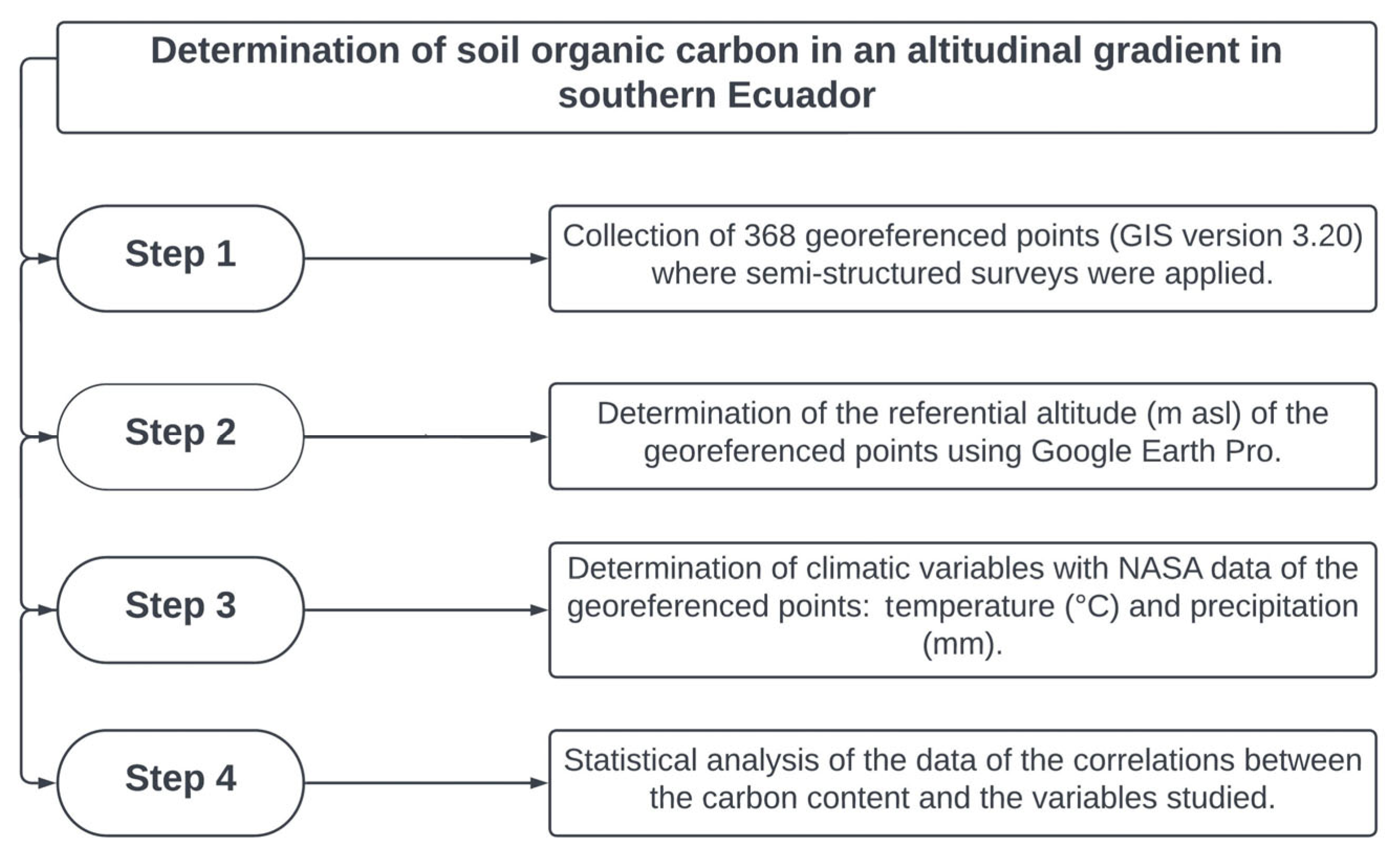
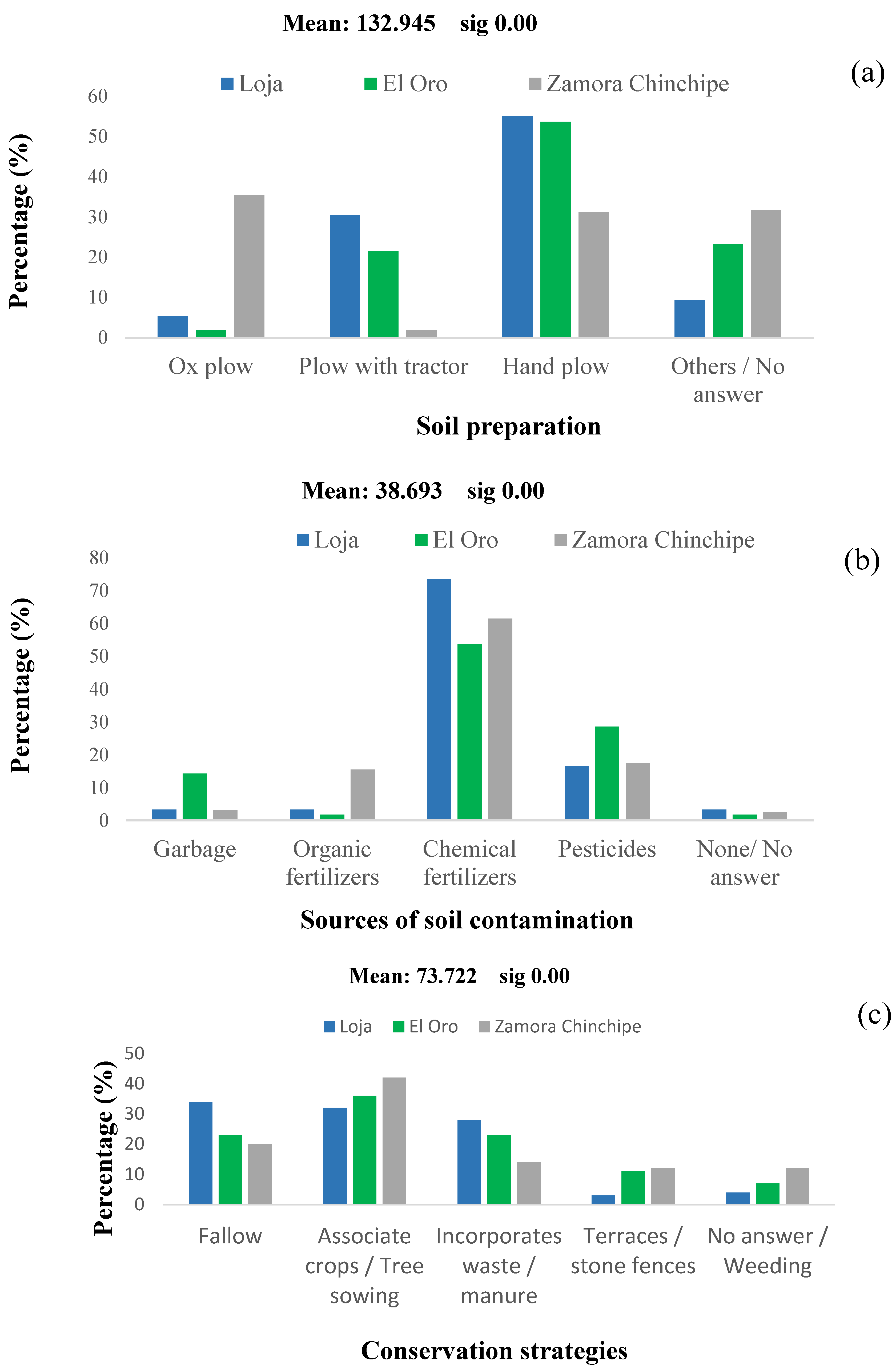
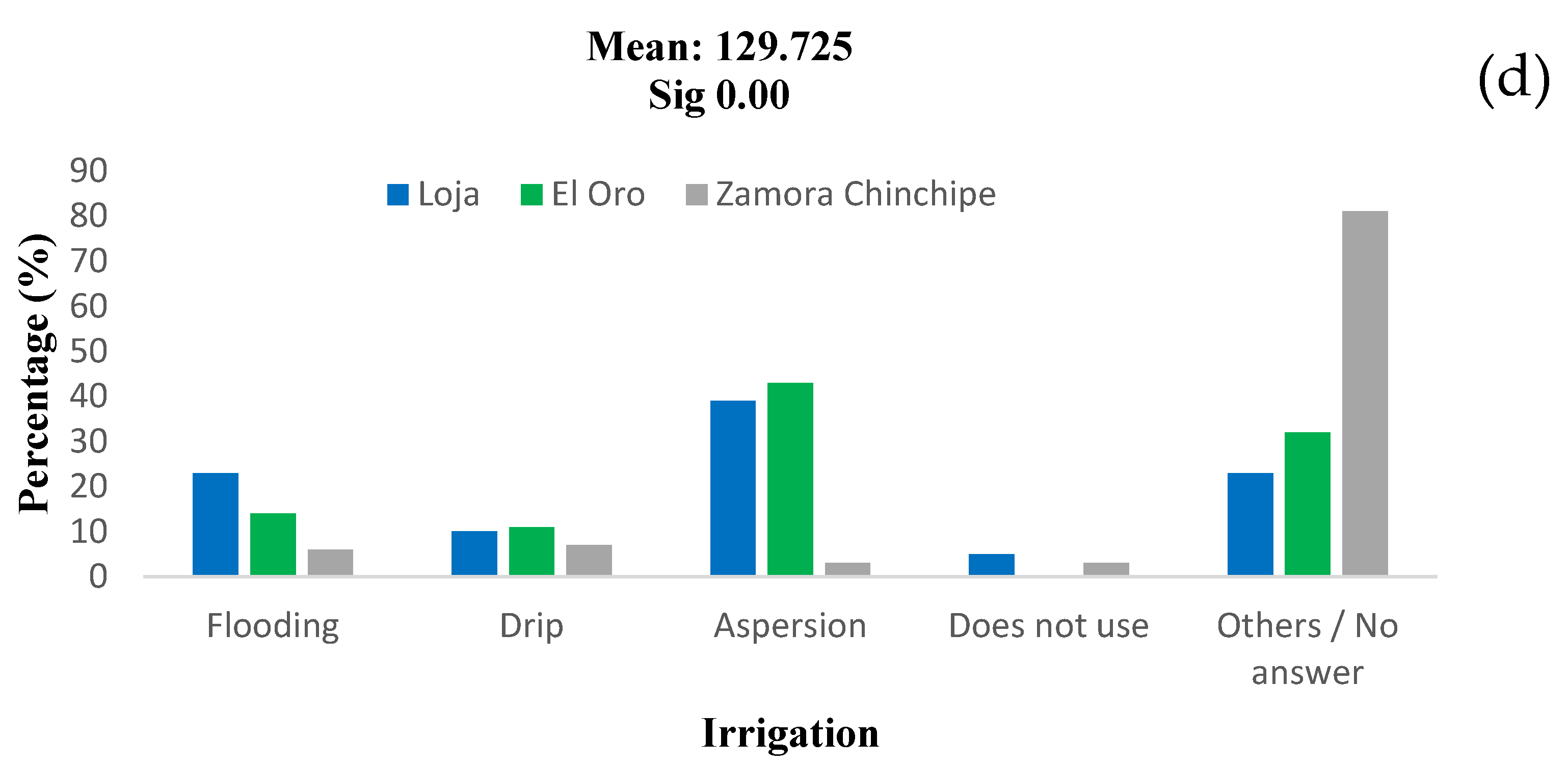
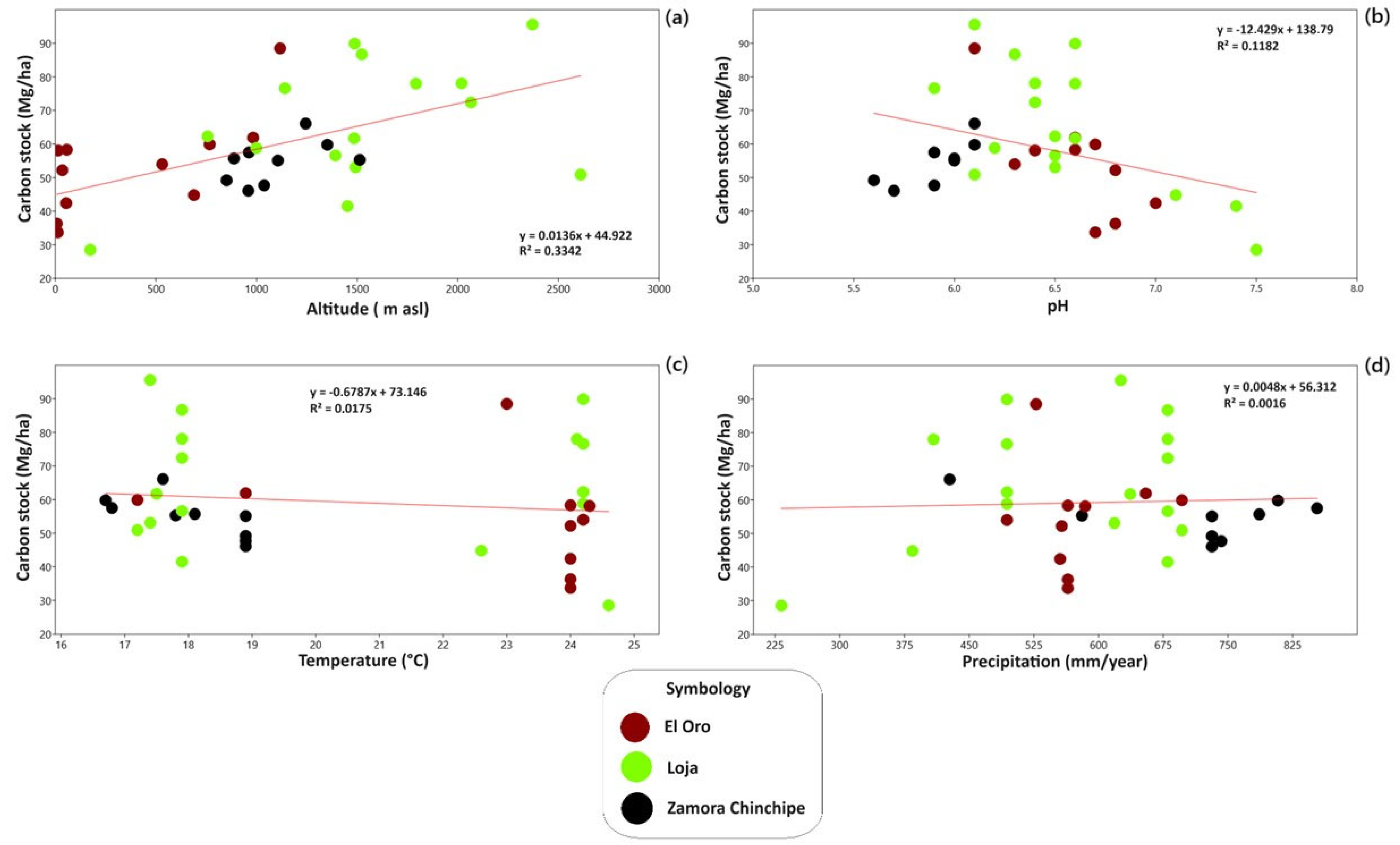
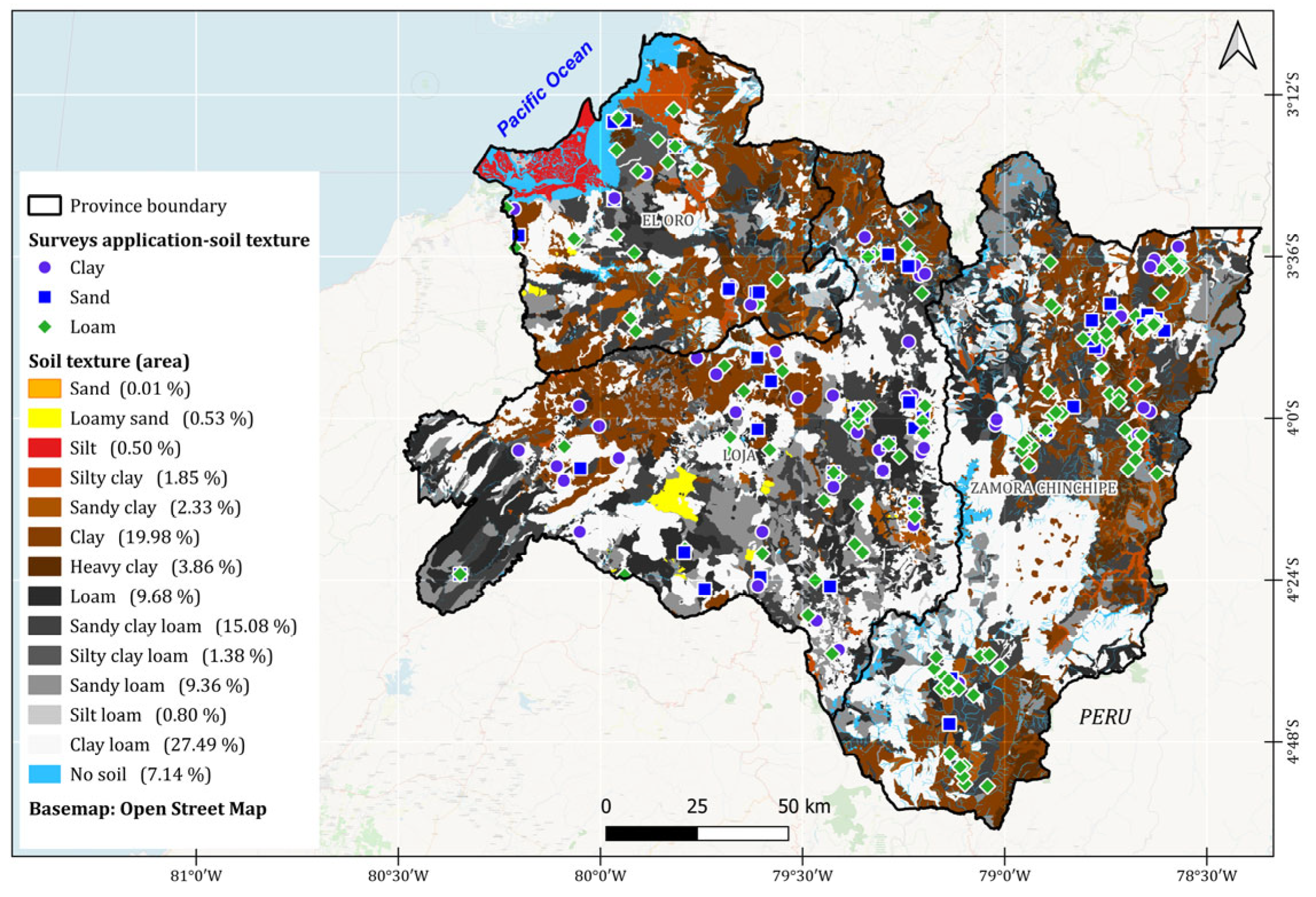

| Loja | El Oro | Zamora Chinchipe | Total | X-Value | Sig (p < 0.05) | ||
|---|---|---|---|---|---|---|---|
| % | % | % | % | ||||
| Age | 17–35 | 21.85 | 16.07 | 44.72 | 30.97 | 37.36 | 0.00 SD |
| 36–55 | 40.40 | 46.42 | 32.23 | 37.77 | |||
| 55–70 | 24.50 | 28.57 | 15.52 | 21.19 | |||
| >70 | 11.26 | 1.78 | 3.72 | 6.52 | |||
| No response | 1.99 | 7.14 | 3.72 | 3.5 | |||
| Ethnicity | Mestizo | 81.46 | 94.64 | 86.33 | 85.59 | 49.59 | 0.00 SD |
| Indigenous | 15.23 | 0.00 | 2.48 | 7.33 | |||
| Caucasian | 0.00 | 1.78 | 11.18 | 5.16 | |||
| Afro-Ecuadorian | 2.65 | 3.57 | 0.00 | 1.63 | |||
| No response | 0.66 | 0.00 | 0.00 | 0.27 | |||
| Education level | Primary | 43.05 | 25.00 | 12.42 | 26.90 | 76.43 | 0.00 SD |
| High school | 30.46 | 48.21 | 36.02 | 35.60 | |||
| Superior | 10.60 | 26.79 | 41.61 | 26.63 | |||
| None | 13.91 | 0.00 | 4.98 | 7.88 | |||
| Others | 1.98 | 0.00 | 4.97 | 2.99 | |||
| Who dedicates more time to agriculture or livestock? | Men | 44.37 | 73.21 | 26.71 | 41.03 | 85.73 | 0.00 SD |
| Women | 9.93 | 3.57 | 6.21 | 7.34 | |||
| All family | 45.03 | 23.22 | 40.99 | 39.95 | |||
| Others/No answer | 0.67 | 0.00 | 26.09 | 11.68 | |||
| Loja | El Oro | Zamora Chinchipe | Total | X-Value | Sig (p < 0.05) | ||
|---|---|---|---|---|---|---|---|
| % | % | % | % | ||||
| It is that soils are colored | Black | 49.67 | 19.64 | 65.84 | 52.17 | 49.60 | 0.00 SD |
| Brown | 34.44 | 66.07 | 20.50 | 33.15 | |||
| Reddish | 3.97 | 3.57 | 5.59 | 4.62 | |||
| Yellow | 7.28 | 10.71 | 5.59 | 7.07 | |||
| White | 0.66 | 0.00 | 0.00 | 0.27 | |||
| Others | 0.66 | 0.00 | 0.62 | 0.54 | |||
| Study Places | Plants in Infertile Soils | Species | Plants in Fertile Soils | Species |
|---|---|---|---|---|
| Loja | Pastures | Paspalum candidum (Flüggé) Kunth., Cynodon dactylon (L.) Pers., Pennisetum clandestinum Hochst. ex Chiov, Pennisetum purpureum Schumach. | Vegetables | Not specified |
| Llashipa | Pteridium aquilinum (L.) Kuhn | Corn | Zea mays L. | |
| Faique | Vachellia macracantha (Humb. and Bonpl. ex Willd.) Seigler and Ebinger | Medicinal plants | Not specified | |
| Shiran/amor seco/huichingue | Bidens pilosa L. | Yucca | Manihot esculenta | |
| Chilca | Baccharis obtusifolia Kunth | Coffee | Coffea arabica | |
| El Oro | Pastures | Cynodon dactylon | Medicinal plants | Aloysia citrodora, Chamaemelum nobile, Mentha piperita, Origanum vulgare, Melissa officinalis, Verbena officinalis, Plantago major, Vaccinium meridionale |
| Banana and plantain | Musa L. | Mango | Mangifera indica | |
| Weeds | Not specified | Cocoa | Theobroma cacao | |
| Citrus | Citrus limon, Citrus reticulata, Citrus sinensis, Citrus aurantium, Citrus aurantiifolia | |||
| Zamora Chinchipe | Shrubs | Vernonanthura patens | Vegetables | Lactuca sativa, Brassica oleracea var. capitata, Coriandrum sativum |
| Moss | Bryopteris filicina | Medicinal plants | Menta piperita, Ruta graveolens, Chamaemelum nobile | |
| Weeds | Echinochloa colona; Trifolium repens | Citrus | Citrus sinensis, Citrus reticulata, Citrus limon | |
| Pastures | Cynodon dactylon, pennisetum merkeri, brachiaria decumbens | Guaba | Inga edulis | |
| Ferns | Pteridium aquilinum | Guayaba | Psidium guajava |
| Study Places | Georeferenced Points | Altitude (Average m a.s.l.) | Temp. °C (Average/Year) | Pp (Average mm/Year) | Carbon Stock (Mg/ha) | pH | |
|---|---|---|---|---|---|---|---|
| El Oro | Machala | 7 | 7 | 24 | 564.4 | 36.3 | 6.8 |
| Huaquillas | 2 | 12 | 24 | 564.4 | 33.7 | 6.7 | |
| El Guabo | 3 | 14 | 24.3 | 584.5 | 58.1 | 6.4 | |
| Pasaje | 10 | 35 | 24.0 | 557.3 | 52.2 | 6.8 | |
| Arenillas | 7 | 54 | 24.0 | 555.4 | 42.4 | 7.0 | |
| Santa Rosa | 8 | 57 | 24 | 564.4 | 58.3 | 6.6 | |
| Marcabelí | 2 | 531 | 24.2 | 493.8 | 54.0 | 6.3 | |
| Piñas | 8 | 983 | 18.9 | 654.7 | 61.9 | 6.6 | |
| Portovelo | 3 | 767 | 17.2 | 696.6 | 59.9 | 6.7 | |
| Zaruma | 6 | 1117 | 23 | 527.6 | 88.5 | 6.1 | |
| Loja | Zapotillo | 5 | 174 | 24.6 | 232.3 | 28.5 | 7.5 |
| Macará | 4 | 689 | 22.6 | 384.3 | 44.8 | 7.1 | |
| Chaguarpamba | 5 | 999 | 24.2 | 493.8 | 58.8 | 6.2 | |
| Pindal | 4 | 756.8 | 24.2 | 493.9 | 62.3 | 6.5 | |
| Puyango | 3 | 1141 | 24.2 | 493.8 | 76.6 | 5.9 | |
| Catamayo | 31 | 1452 | 17.9 | 680.1 | 41.5 | 7.4 | |
| Paltas | 5 | 1392 | 17.9 | 680.2 | 56.6 | 6.5 | |
| Calvas | 5 | 1485 | 17.5 | 636.6 | 61.7 | 6.6 | |
| Celica | 5 | 1487 | 24.2 | 493.8 | 89.9 | 6.6 | |
| Espíndola | 5 | 1492 | 17.4 | 618.3 | 53.1 | 6.5 | |
| Olmedo | 5 | 1523 | 17.9 | 680.2 | 86.7 | 6.3 | |
| Sozoranga | 5 | 1792 | 24.1 | 408.6 | 78.0 | 6.6 | |
| Saraguro | 30 | 2611 | 17.2 | 696.6 | 50.9 | 6.1 | |
| Loja | 28 | 2019 | 17.9 | 680.2 | 78.1 | 6.4 | |
| Gonzanamá | 6 | 2066 | 17.9 | 680.2 | 72.4 | 6.4 | |
| Quilanga | 5 | 2371 | 17.4 | 625.7 | 95.6 | 6.1 | |
| Zamora Chinchipe | Paquisha | 3 | 851 | 18.9 | 731.4 | 49.2 | 5.6 |
| Yantzaza | 59 | 888 | 18.1 | 786.3 | 55.7 | 6.0 | |
| Nangaritza | 10 | 959 | 18.9 | 731.4 | 46.1 | 5.7 | |
| El Pangui | 15 | 962 | 16.8 | 853.2 | 57.5 | 5.9 | |
| Zamora | 33 | 1038 | 18.9 | 742.2 | 47.7 | 5.9 | |
| C. del Cóndor | 6 | 1106 | 18.9 | 731.4 | 55.1 | 6.0 | |
| Chinchipe | 7 | 1244 | 17.6 | 427.4 | 66.1 | 6.1 | |
| Yacuambi | 3 | 1352 | 16.7 | 807.9 | 59.8 | 6.1 | |
| Palanda | 25 | 1513 | 17.8 | 580.8 | 55.3 | 6.0 | |
| Altitude (Average m a.s.l.) | Temperature °C (Average/Year) | Precipitation (Average mm/Year) | Carbon Stock (Mg/ha) | pH | |
|---|---|---|---|---|---|
| Altitude (Average m a.s.l.) | 1 | ||||
| Temp, °C (average/year) | −0.62982 | 1 | |||
| Pp (Average mm/year) | 0.28583 | −0.71911 | 1 | ||
| Carbon stock (Mg/ha) | 0.57806 | −0.13231 | 0.039809 | 1 | |
| pH | −0.3319 | 0.37478 | −0.51917 | −0.34383 | 1 |
| Elevation Range (m a.s.l.) | Temp. °C (Year) | Precipitation (mm year−1) | Carbon Stocks (Mg/ha) |
|---|---|---|---|
| 0–500 | 24.1 ± 0.2 a | 517.5 ± 126.0 a | 44.2 ± 12.1 a |
| 501–1000 | 20.4 ± 3.0 ab | 631.9 ± 155.0 a | 55.0 ± 6.4 ab |
| 1001–1500 | 19.5 ± 2.9 b | 621.8 ± 121.0 a | 63.3 ± 15.7 ab |
| 1501–2000 | 19.9 ± 3.6 ab | 556.5 ± 137.0 a | 73.3 ± 16.2 b |
| 2001–2500 | 17.6 ± 0.4 b | 670.7 ± 31.0 a | 74.3 ± 18.4 b |
| Scientific Knowledge (USDA) | Local Knowledge | ||
|---|---|---|---|
| Textural Class | Percentage (%) | Textural Class | Percentage (%) |
| Sand | 9.9 | Sandy | 13.85 |
| Loamy sand | |||
| Sandy loam | |||
| Loam | 54.93 | Loamy (intermediate or balanced) | 64.13 |
| Silt loam | |||
| Clay loam | |||
| Silty clay loam | |||
| Sandy clay loam | |||
| Silt | |||
| Clay | 28.02 | Clayey | 20.92 |
| Sandy clay | |||
| Silty clay | |||
| No soil | 7.14 | Did not respond | 1.08 |
| Local Knowledge | Scientific Knowledge | Local Knowledge | |||
|---|---|---|---|---|---|
| How Do You Consider the Soils on Your Farm? | Percentage (%) | Carbon Stocks (t ha−1) | Percentage (%) | Color | Percentage (%) |
| Very good | 29.08 | High | 40.67 | Black | 52.17 |
| Suitable | 61.96 | Middle | 52.48 | Brown | 33.15 |
| Poor | 6.79 | Low | 6.85 | Red Yellow White | 11.96 |
| Did not respond | 2.17 | Did not respond | 2.72 | ||
Disclaimer/Publisher’s Note: The statements, opinions and data contained in all publications are solely those of the individual author(s) and contributor(s) and not of MDPI and/or the editor(s). MDPI and/or the editor(s) disclaim responsibility for any injury to people or property resulting from any ideas, methods, instructions or products referred to in the content. |
© 2025 by the authors. Licensee MDPI, Basel, Switzerland. This article is an open access article distributed under the terms and conditions of the Creative Commons Attribution (CC BY) license (https://creativecommons.org/licenses/by/4.0/).
Share and Cite
Hualpa, G.; Carrión-Paladines, V.; Jiménez, W.; Capa-Mora, D.; Quichimbo, P.; Fierro, N.; Jiménez, L. Farmers’ Indigenous Knowledge of Soil Management in an Altitudinal Gradient in Southern Ecuador. Sustainability 2025, 17, 4983. https://doi.org/10.3390/su17114983
Hualpa G, Carrión-Paladines V, Jiménez W, Capa-Mora D, Quichimbo P, Fierro N, Jiménez L. Farmers’ Indigenous Knowledge of Soil Management in an Altitudinal Gradient in Southern Ecuador. Sustainability. 2025; 17(11):4983. https://doi.org/10.3390/su17114983
Chicago/Turabian StyleHualpa, Génesis, Vinicio Carrión-Paladines, Wilmer Jiménez, Daniel Capa-Mora, Pablo Quichimbo, Natacha Fierro, and Leticia Jiménez. 2025. "Farmers’ Indigenous Knowledge of Soil Management in an Altitudinal Gradient in Southern Ecuador" Sustainability 17, no. 11: 4983. https://doi.org/10.3390/su17114983
APA StyleHualpa, G., Carrión-Paladines, V., Jiménez, W., Capa-Mora, D., Quichimbo, P., Fierro, N., & Jiménez, L. (2025). Farmers’ Indigenous Knowledge of Soil Management in an Altitudinal Gradient in Southern Ecuador. Sustainability, 17(11), 4983. https://doi.org/10.3390/su17114983






